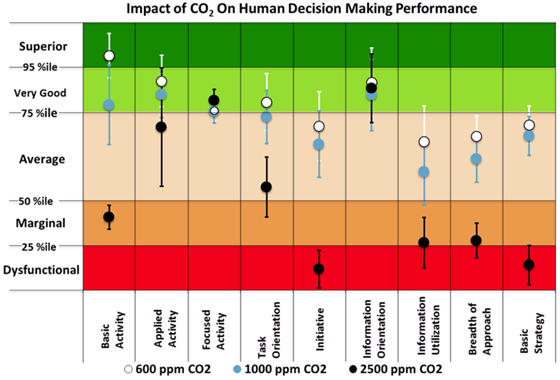 |
| Ambient carbon dioxide concentration and cognitive capacity. Image source: Satish et al.. |
But two recent papers from top research labs show that, contrary to expectation, rather small increases in atmospheric carbon dioxide concentration sharply impair some vitally important cognitive capacities.(2,3) In both studies, experimental subjects were tested on various types of cognitive tasks ranging from mundane busy work to the exercise of initiative, and strategic thinking. What they found was that over a range of carbon dioxide concentrations commonly occurring in air-conditioned school and office buildings, performance on tasks requiring higher cognitive functions were significantly or catastrophically reduced at the higher carbon dioxide concentrations, whereas performance on more mundane tasks was largely unaffected.
These papers, which deserve reading in their entirety by anyone with a serious interest in human intellectual performance in general or in their own performance or that of their subordinates or employees, remind one of the theory that Rome collapsed because of lead in the water due to the extensive use by the Romans of lead-pipe plumbing. Could it be that we in the West are Hell bent for collapse for a similarly mundane reason, in our case the cause being carbon dioxide in the air supply of the air-conditioned buildings in which most decision-makers and professionals now work?
The more one thinks about it the more Donald Trump's insistence that "We are led by very, very stupid people" seems credible. This sad state of affairs could simply be the result of a combination of the carbon dioxide dome over Washington DC, plus inadequate ventilation of the Oval Office and the Capitol.
(1) Vercruyssen, Max, et al. 2007. Effects of Carbon Dioxide Inhalation on Psychomotor and Mental Performance During Exercise and Recovery. Intl. J. Occup. Safety & Ergonomics. 13:15–27.
(2) Satish, Usha, et al. 2012. Is CO2 an Indoor Pollutant? Direct Effects of Low-to-Moderate CO2 Concentrations on Human Decision-Making Performance. Env. Health Perspect. 120:1671–1677.
(3) Allen, Joseph G. et al. 2015. Associations of Cognitive Function Scores with Carbon Dioxide, Ventilation, and Volatile Organic Compound Exposures in Office Workers: A Controlled Exposure Study of Green and Conventional Office Environments. Environ. Health Perspect. Adv. Publication.
Related:
CanSpeccy: Rising Atmospheric Carbon Dioxide Concentration, Part IV: Reversing the Trend
CanSpeccy: Rising Atmospheric Carbon Dioxide Concentration, Part II: Ecosystem Disruption
CanSpeccy: Rising Atmospheric Carbon Dioxide Concentration, Part I: Carbon Dioxide Is Not a Greenhouse Gas



